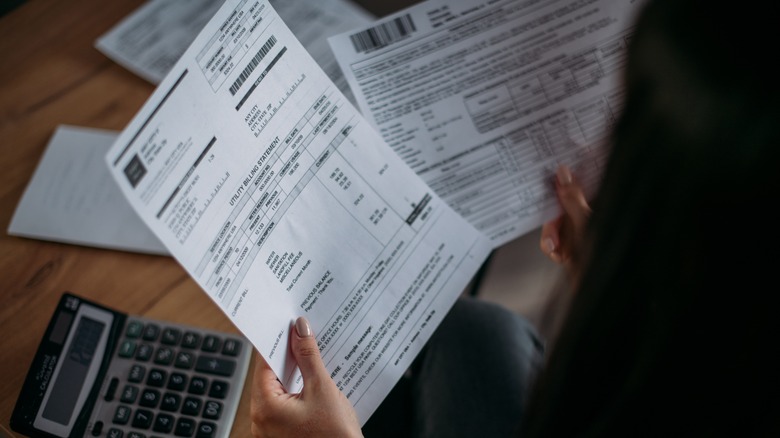Behind On Bills? Get Your Budget In Check With These Simple Steps
When you're facing a financial hurdle, knowing where to start to improve it can feel overwhelming. The worry of where to get extra income can be mentally and physically taxing, especially if you decide to take on extra jobs or commitments in order to pay those past-due bills. Some go to extreme measures to scrounge up cash, while others stick to answers on social media outlets, like TikTok's "financial cleanse," to help manage their money better.
Though payments may be stacking up, don't let the fear of catching up paralyze you. In fact, it's imperative for your motivation and self-esteem to avoid spiraling thoughts and narratives. Whether you have to write encouraging Post-It notes to yourself or ask a friend to help keep you accountable with spending goals, the best thing in this situation is to keep morale high and not to dwell on the dominoes that could fall, like late fees or a damaged credit score. In order to move forward, you must take the first step. It can be as easy as investing a day or two to budget a practical, yet encouraging, financial game plan.
Look at what you have
If you feel alone in the budgeting process, know that many others share in your financial worries. Some 64% of Americans live paycheck to paycheck and rely on budgeting tactics to track their finances and save for the future. Even 42% of people who make six figures feel it too. In moments of hopelessness, you must lean into the glass-half-full mentality — meaning it's beneficial to make a list of what assets and income you already have.
Step one to getting your budget in check: start by writing down your current savings and pay dates, and roughly what each paycheck looks like from month to month. For those living paycheck to paycheck, turning to the eye of the storm is actually beneficial because it helps us stay grounded and realistic of our expectations. A good way of doing this is to focus on your take-home pay. This take-home pay is the remaining balance of an income after subtracting deductions like taxes, social security, and health insurance plans.
If you don't know your minimum take-home pay, look over your last three monthly pay stubs and look for the one with the lowest total amount. You can use that value specifically in your monthly financial budget.
Try user-friendly trackers
Step two towards a beneficial budget is to utilize budgeting tools. Many websites offer free budgeting templates and expense trackers to make listing and tracking your purchases headache-free. These tools are a great start for any size budget because they keep records organized and accessible. Using templates and writing to-do lists also improves cognitive functions like memorization. By utilizing a financial tracker, your brain is encouraged to remember payments and deadlines more frequently, so you can catch up to the financial goal you're chasing.
Many trackers will also ask you to list specific expenses in your budget. Look back at the previous two months of fixed income (a set quota that rarely changes) and write down the average total spending for each expense made with that income. Then, break up your purchases into categories like rent, food, and clothing. Afterward, add the total amount to your budget. This will inform you of how much you should save to purchase similar items in the future, when you're able to catch up on those bills or reach your financial goal.
Take your time
Step three can be as easy as it is challenging, and that's to take your time. Everything has its own season and timeline, and budgeting is no exception. Set aside enough hours a week so you can sit down with your ambitions and address them all individually. Setting aside time to articulate goals will keep you from rushing into spending money, and also help sift through any subgoals that might spring up.
These subgoals are the building blocks that may help you reach your larger goals. They are imperative when it comes to budgeting because without them, tackling long-term goals can be overwhelming, if not murky and unclear. Bank of America specifically defines short-term goals as tiers that take at least three years to complete. Examples of such goals include but are not limited to emergency funds, credit card debt payments, memberships (gym, subscriptions, etc.), and vacations. On the opposite end, examples of long-term goals range from retirement plans to education, which again, may take decades to finish.
Keep a paper trail
Step four incorporates organization into your budget, similar to how you would organize a room. Having a paper trail of receipts is a great way to track past purchases and see exactly where your money is going. A helpful tip: keep a small envelope or file accordion by your driver's seat. That way, any time you make a purchase and come back to your car, you can file it into your budgeting system. Then, at the end of each month, you can pull those receipts out and track purchases and expenses. This is also handy in tax season and can help identify specific items and purchases you can use as tax deductions.
Another way to physically organize your budgeting system is to keep all records and templates in a journal or small binder. A budget binder acts like a recipe book for your templates and financial tracking. It will help alleviate the stress of finding documents, and make it convenient to look back on financial records and goal tracking.
Get creative
Step five is the action stage, where you focus on decreasing spending. Easier said than done, right? The point of taking action isn't to overwhelm yourself with busywork and side hustles, but rather to get creative and specific with your time and energy. What non-necessities are you willing to cut out of your expenses in order to make room for savings down the road?
It's easy to say you can cut back on food purchases by cooking at home and not eating out. However, what if savings go beyond that? What if it means investing in non-perishables so that your food lasts longer? What if you fill up on gas before hitting empty, and opt for that less-than-convenient gas station that's 30 cents cheaper, as opposed to the station closer to your home? Another out-of-the-box idea is to literally pull the plug on appliances. Leaving the plug in the outlet for long periods of time raises your electricity bill. When you're done using it, unplug it! You're sure to see a difference in your monthly bill as a result.
That being said, seeing a difference in your savings as a whole will take time and dedication. Keep committing to your cut expenses, savings plan, and financial goals. The reward for your efforts is sure to be a substantial one.





